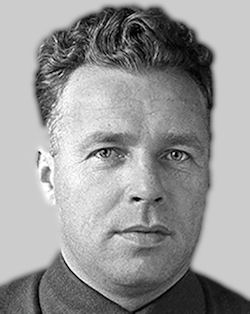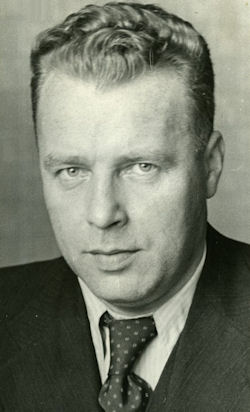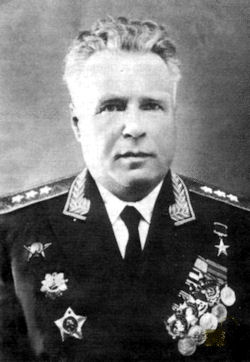Alexey Ivanovich Shakhurin
 Alexey Ivanovich Shakhurin (1904-1975) was Colonel-General of the engineering and aviation service (1944) and Hero of Socialist Labor (1941). During the Great Patriotic War, Alexei Shakhurin was called a great Commissar. He stood at the head of the aviation industry since the pre-war 1940. What importance was attached then to aviation and why, it is not worth explaining. The names of the famous designers Tupolev and Mikoyan, Yakovlev and Ilyushin, Lavochkin and Myasishchev we proudly pronounce today. The exploits of the pilots who smashed the enemy on the machines they created are not forgotten. The outcome of those great battles largely decided our advantage in the air. But in order for this to happen, not only talented designers and aviators were needed, but also gifted organizers were needed.
Alexey Ivanovich Shakhurin (1904-1975) was Colonel-General of the engineering and aviation service (1944) and Hero of Socialist Labor (1941). During the Great Patriotic War, Alexei Shakhurin was called a great Commissar. He stood at the head of the aviation industry since the pre-war 1940. What importance was attached then to aviation and why, it is not worth explaining. The names of the famous designers Tupolev and Mikoyan, Yakovlev and Ilyushin, Lavochkin and Myasishchev we proudly pronounce today. The exploits of the pilots who smashed the enemy on the machines they created are not forgotten. The outcome of those great battles largely decided our advantage in the air. But in order for this to happen, not only talented designers and aviators were needed, but also gifted organizers were needed.
Alexei Shakhurin hailed from the village of Mikhailovskoye, near the Bitsa station. At the beginning of the 20th century it was located 20 kilometers from the capital. The peasants could not feed themselves on the land, the men were drawn to Moscow enterprises. At the factory of Gakental, as at that time the Manometer plant was called, Ivan Matveyevich Alexey Shakhurin’s father and Alexey Shakhurin’s father and fellow villagers came to work as a tinker. He perfectly mastered his business, for which he was highly respected at the factory, where he worked for 40 years. His mother, Tatyana Mikhailovna, was endowed with great spiritual forces, with the gift of inner tact. The children tried to do everything themselves, grew up independently, and when the father went to the front of the Great War, the mother consulted with 10-year-old Alyosha, and he was the eldest son, as an adult.
The “Labor University” of Alexey began at the age of 13: he entered the electrical engineering office as a student. And six months later, the Revolution broke out. And then the life of Alexei Shakhurin, as well as the entire country, rushed, gaining unprecedented speed. At 16, he worked as an electrician, two years later, on the recommendation of his father, he came to the Manometer factory.
He joined the Komsomol in 1925 and actively working with young people. Soon he was invited to the district Komsomol committee. According to Lenin's call in 1924, he joined the Communist Party. Becomes a member of the Central Committee of the Komsomol. In 1927 he passed exams in the Engineering and Economic Institute imeni S.Ordzhonikidze. It was then that the aircraft industry first appeared in the life of Alexei Shakhurin. The militant motto of the youth of the 1920s was the call: “Working people, build the Air Fleet”. The Society of Friends of the Air Fleet was established in the country. And in the society of Marxist technicians, famous scientists and practitioners read lectures and reports on aviation topics. Shakhurin was appointed head of the production organization department at one of the plants of the Civil Air Fleet. The factory was soon redeveloped, and from 1933 to 1938, Alexey Ivanovich worked as an engineer at the Air Force Academy Zhukovsky, which at that time was the only higher military aviation educational institution that trained engineers and designers.
In February - April 1938, Aleksey Ivanovich - party organizer at the plant number 1 "Aviakhim". Then he heads the Yaroslavl regional committee of the party, less than a year later he occupies the same post in Gorky. Since March 1939 - a member of the Central Committee of the party. Of course, he had, as they would say now, a successful career. But behind his success, above all, there was intense work, organizational talent, the ability to inspi re people and skillfully arrange them in places,
 At the age of 36 he was appointed Commissar of the aviation industry. The appointment of the people's commissar of the aviation industry was a complete surprise for Alexei Ivanovich. In the first days of January 1940, Shakhurin was urgently called to Moscow from Gorky (now Nizhny Novgorod), where he headed the regional committee of the CPSU (B). He was waited in the Kremlin. Alexey Ivanovich Shakhurin later recalled: “Stalin, Molotov, Voroshilov and other members of the Politburo were in the office . Everyone except Stalin, who walked around the room, sat. Stalin silently continued walking for some time. Then he stopped near me and said: “We want to appoint you as Commissar of the Aviation Industry. We are looking for fresh people, good organizers and knowing the same aviation business. How do you look at it?"
At the age of 36 he was appointed Commissar of the aviation industry. The appointment of the people's commissar of the aviation industry was a complete surprise for Alexei Ivanovich. In the first days of January 1940, Shakhurin was urgently called to Moscow from Gorky (now Nizhny Novgorod), where he headed the regional committee of the CPSU (B). He was waited in the Kremlin. Alexey Ivanovich Shakhurin later recalled: “Stalin, Molotov, Voroshilov and other members of the Politburo were in the office . Everyone except Stalin, who walked around the room, sat. Stalin silently continued walking for some time. Then he stopped near me and said: “We want to appoint you as Commissar of the Aviation Industry. We are looking for fresh people, good organizers and knowing the same aviation business. How do you look at it?"
"Soon they invited designer A. S. Yakovlev. Stalin pointed to me: "This is a new Commissar of the aviation industry, Comrade Shahurin." I realized that the issue of my appointment was resolved. Stalin asked me: "How old are you?" “Thirty-five,” I said. “Well, you see,” he threw to Yakovlev, “what a young Commissar you have.” It's good. I noticed that with the arrival of Yakovlev, Stalin had a joking tone. Before that, it seemed to me, there were notes of doubt and concern in his voice. Coming back to me, Stalin said: "Comrade Yakovlev will be your deputy for experimental aircraft construction. We'll talk about other deputies later.""
Aleksey Ivanovich was distinguished by a rare directness and surprising personal modesty. He enjoyed great prestige and respect from his colleagues. He was the People's Commissar, who was assisted by everyone: I.F. Tevosyan, D.F. Ustinov, M.G. Pervukhin and others. Somehow Parshin, the People's Commissar of General Machine-Building, joked in a friendly way: "Aleksey Ivanovich, and if you asked for 100 pieces of polar bears, you probably would not have refused."
In February 1939, a meeting was held in the Central Committee of the Party with the participation of members of the Politburo, the leaders of the Air Force and the aviation industry, aircraft designers, pilots, who outlined a specific program for the development of Soviet aviation and equipment with modern technology. The main attention was paid to the development of new types of aircraft, primarily fighters. One after another, a number of important decisions of the Central Committee of the Party and the Council of People's Commissars of the USSR on the development of the aviation industry and the creation of new combat aviation equipment followed. Among these measures were changes in the leadership of the People's Commissariat of the aviation industry. The new Commissar was faced with difficult tasks, and he fulfilled them with honor.
In 1939-1941, new models of combat aircraft were built, tested, put into service and put into mass production. Compared to 1937, the number of plants in the industry grew by 1.7 times; by the summer of 1941, the industry’s capacities significantly exceeded Germany’s aircraft production capacity. In 1939-1940, the USSR produced more aircraft than Germany. However, Germany produced only new types of aircraft, and the USSR produced partially old types of aircraft.
A new big task had arisen - to build 9 new aviation and 6 new aircraft engine plants. In 1941, aircraft factories produced 2,000 Yak-1, LaGG-3, MiG-3 fighters, 458 Pe-2 bombers, 249 Il-2 attack aircraft.
Alexey Ivanovich, when necessary, firmly defended his opinion from the Supreme. So, Stalin banned the serial production of the dive-bomber TU-2, preferring fighters. Shahurin argued that this can not be done. However, it was not possible to convince Stalin. And only the TU-2 final test report submitted to the Commissariat in combat decided the dispute in favor of Shakhurin. Under the act was the signature of the famous pilot, Major General Aviation M.M. Gromov. On the same day Stalin summoned Shakhurin to himself. On his desk lay the same act, where the front-line pilots praised the car. Stalin wondered if Shakhurin knew about this? Shakhurin sharply replied that he not only knew, but also reported the question for a while, for which he received an unpleasant reprimand. Then Stalin, realizing that he was wrong, joked....
In the initial period of the war, about 85 percent of the enterprises of the entire aviation industry, which had established economic ties with allied factories, had to withdraw from their habitable places in the western regions of the country, along with the entire country, the aviation industry was tested for survivability.
One hundred aircraft factories, about one million units of the machine park of the industry, more than 500 thousand workers, not counting family members, were subject to a “march” in the Trans-Volga region, to the Urals, to Siberia and Central Asia. And all this had to be done without reducing the level of production of combat aircraft in the shortest possible time, within 10 days. To accomplish these tasks, it was necessary to drastically increase productivity in those plants that were not subject to evacuation or were filmed at a later date. Thus, the aircraft factories of Moscow and other enterprises of the center were evacuated from mid-October 1941, but by that time the enterprises of the aviation industry evacuated from the western regions should have produced much-needed products for the active army.
On 20 December 1941, the evacuation of the Moscow plants was completed, and Shakhurin reported this to Stalin. The Supreme ordered, together with Molotov, to travel by plane to Kuibyshev. A plant for the production of attack aircraft IL-2 was deployed in Kuibyshev. Supervised the work of E.E. Kofman, a good organizer and business executive. Shakhurin himself stayed at the factory sites until midnight, and then returned to Kuybyshev, where only two rooms were allocated to the people's commissariat, and contacted by telephone the directors of factories and their remaining employees in Moscow. Having set up work in Kuibyshev, Alexey Ivanovich headed for the Urals, where things were not going well, and even in the harsh conditions of the Ural winter.
In 1941, with the beginning of the war, despite the difficult military conditions, there was an increase in the production of aircraft. If by the end of June, the aircraft industry produced about 50 aircraft per day (1500 per month), then in July they were produced 1807, in September 329 aircraft. By the end of September, the daily report at the State Defense Committee on aircraft construction was 100 aircraft per day. In total, during the period of the Great Patriotic War, the aviation industry mastered and put into mass production 25 types of new and modernized types of aircraft and 23 types of aircraft engines. By May 9, 1945, 47.3 thousand combat vehicles consisted in the combat formation of Soviet aviation.
 After the end of the war, Stalin, as is well known, took care of clearing the Olympus on which he sat, from those with whom he had to share the glory of Victory. At the end of the war, not without the participation of the responsible for the aviation industry in the GKO and Central Committee, G.M. Malenkov was started a case against Shahurin. In March 1946, A.I. Shakhurin was unexpectedly arrested, and, as was done in such cases, without the sanction of the prosecutor.
After the end of the war, Stalin, as is well known, took care of clearing the Olympus on which he sat, from those with whom he had to share the glory of Victory. At the end of the war, not without the participation of the responsible for the aviation industry in the GKO and Central Committee, G.M. Malenkov was started a case against Shahurin. In March 1946, A.I. Shakhurin was unexpectedly arrested, and, as was done in such cases, without the sanction of the prosecutor.
Together with A.I. Shakhurin found himself in prison as the Commander-in-Chief of the Air Force, A.A. Novikov, Chief Engineer of the Air Force A.K. Repin, member of the Military Council of the Air Force N.S. Shimanov, Head of the Main Directorate of Air Force Orders N.P. Seleznev, heads of aviation departments of the Central Committee of the CPSU (b) A.V. Budnikov and G.M. Grigorian. They were all accused of "anti-state" practice, of "dragging" during the war and in the post-war period into arming airplanes and engines with large marriages or serious design and production deficiencies, of "hiding"
This absurdity was composed despite the fact that Shakhurin was awarded the title of Hero of Socialist Labor for his work before the war, and was awarded with many state awards. The “case” of Shakhurin and those who were with him in custody were directly fabricated by the Minister of State Security of the USSR Abakumov. Shakhurin was sentenced May 10-11, 1946 by the Military Collegium of the Supreme Court of the USSR chaired by V. V. Ulrich for 7 years on charges of "exceeding power" and "the release of non-standard, substandard and incomplete products." It is noteworthy that, of all the numerous corps of the leaders of the aviation industry - from the deputy people's commissar to the director of the smallest aircraft factory - not one was tried. Shahurin did not pull anyone along.
The fate of those arrested in the “aviation industry” case was different: someone was shot, someone like Shakhurin and Novikov were rehabilitated after Stalin’s death. On May 29, 1953 he was rehabilitated and released, and on June 2, 1953 all awards and titles were returned.
From August 1953 he was Deputy Minister of Aviation Industry of the USSR. In 1954-1956, he became First Deputy Minister of Aviation Industry of the USSR. From July 1957 he was Deputy Chairman of the State Committee of the Council of Ministers of the USSR for External Economic Relations. Since 1959 - retired. He was awarded two Orders of Lenin, the Order of the Red Banner, the Order of Suvorov, First Class, the Order of Kutuzov, First Class, the Order of the Red Banner of Labor, and the Order of the Red Star. He was buried in Moscow at the Novodevichy cemetery. Shakhurin was author of the memoirs "Wings of Victory" (Moscow, 1990).
|
NEWSLETTER
|
| Join the GlobalSecurity.org mailing list |
|
|
|

